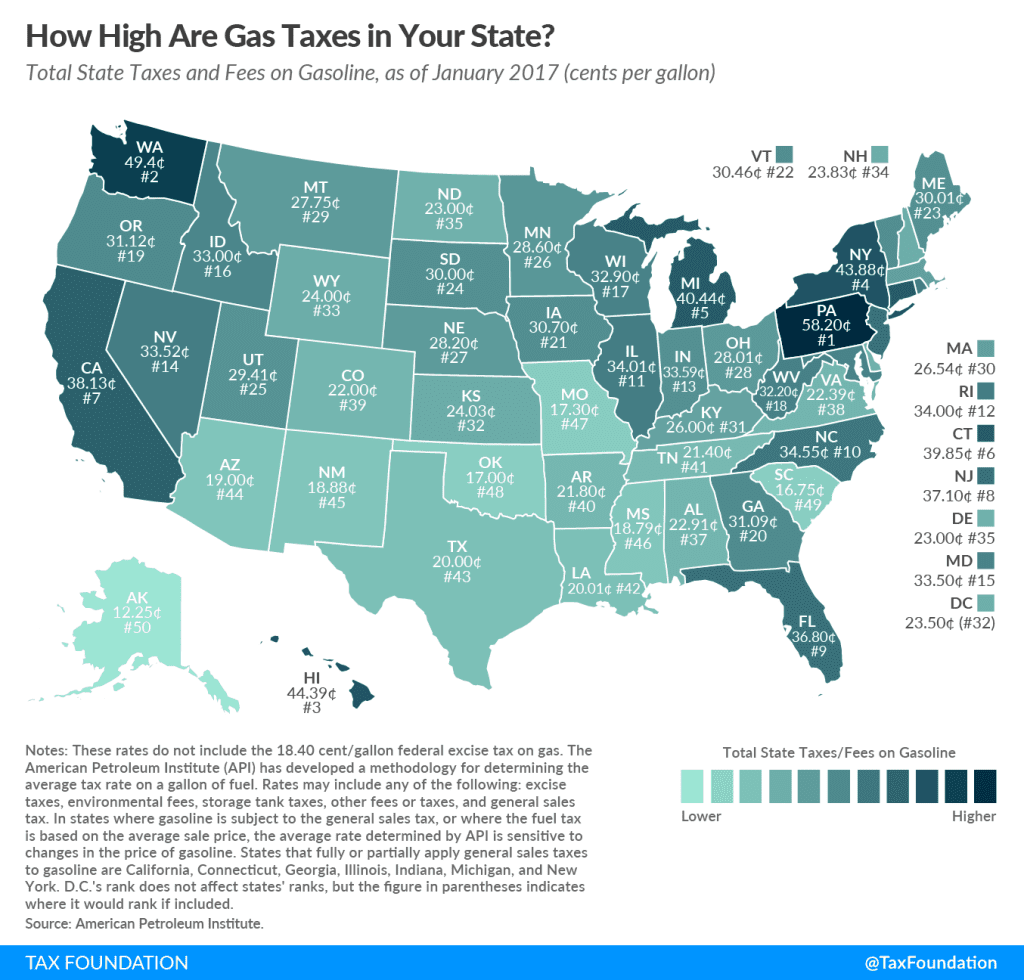This week’s map shows the gas taxA tax is a mandatory payment or charge collected by local, state, and national governments from individuals or businesses to cover the costs of general government services, goods, and activities. rate in each state as of January 1, 2017, using data from the American Petroleum Institute. These taxes can vary widely. The highest state gas taxA gas tax is commonly used to describe the variety of taxes levied on gasoline at both the federal and state levels, to provide funds for highway repair and maintenance, as well as for other government infrastructure projects. These taxes are levied in a few ways, including per-gallon excise taxes, excise taxes imposed on wholesalers, and general sales taxes that apply to the purchase of gasoline. is assessed in Pennsylvania, at 58.2 cents per gallon, with Washington State (49.4 cpg) and Hawaii (44.39 cpg) following closely behind. Alaska drivers pay the lowest rate in the country at 12.25 cents per gallon. These figures do not include the 18.4 cpg federal gas tax.


While usually not adored by taxpayers, gas taxes do conform relatively well with the public finance concept known as the “benefit principle,” meaning that as a general rule, the gas tax revenue accumulated from drivers goes toward the provision of government services that benefit drivers: the construction, maintenance, and repair of roads. This connecting of road costs with the people who use the roads encourages efficient use, minimizing traffic and wear on the road bed.
In fiscal year 2013, however, gas taxes, tolls, and motor vehicle license fees covered just 41.4 percent of state and local road spending. That percentage is falling over time as state gas tax rates in many states are not indexed for inflationInflation is when the general price of goods and services increases across the economy, reducing the purchasing power of a currency and the value of certain assets. The same paycheck covers less goods, services, and bills. It is sometimes referred to as a “hidden tax,” as it leaves taxpayers less well-off due to higher costs and “bracket creep,” while increasing the government’s spending power. , so the revenue they accumulate has weaker purchasing power each year. Of course, cars are also becoming more fuel-efficient all the time, and that makes for less gas tax collections each year as well.
One unintended consequence of lower fuel tax revenue is that legislators are occasionally tempted to seek road funding from more growth-damaging taxes like income and sales taxA sales tax is levied on retail sales of goods and services and, ideally, should apply to all final consumption with few exemptions. Many governments exempt goods like groceries; base broadening, such as including groceries, could keep rates lower. A sales tax should exempt business-to-business transactions which, when taxed, cause tax pyramiding. es, whose payers may or may not be heavy users of roads.
States assess gas taxes in a variety of ways. Some states assess a “specific” tax, a per-gallon tax rate that is collected at the pump. Other states charge wholesalers an “ad valorem” tax on the wholesale price of a gallon, and some states assess an ad valorem sales tax on the purchase of gasoline. The American Petroleum Institute’s data above adjusts for these differences in the application of taxes and calculates the average tax rateThe average tax rate is the total tax paid divided by taxable income. While marginal tax rates show the amount of tax paid on the next dollar earned, average tax rates show the overall share of income paid in taxes. on a gallon of fuel in each state for easy comparability.
Errata: The original version of this blog post listed the incorrect gas tax rate for Pennsylvania in the first paragraph and an incorrect rate for Illinois on the map. Both errors have been corrected.
Share